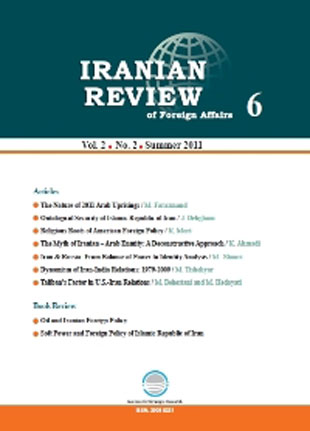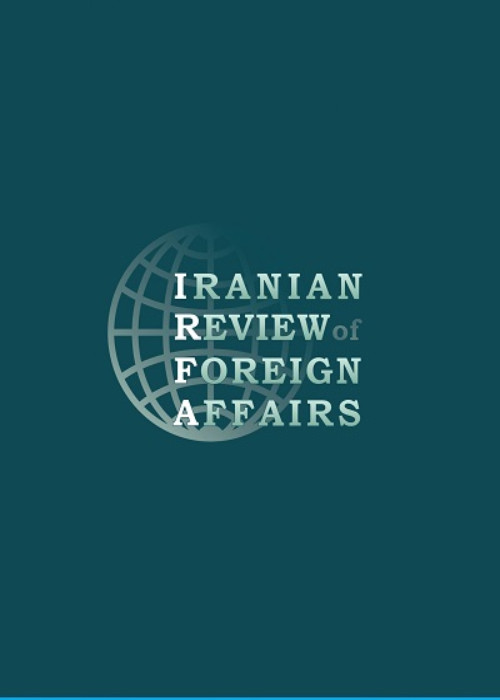فهرست مطالب

Iranian Review of Foreign Affairs
Volume:2 Issue: 2, Summer 2011
- تاریخ انتشار: 1390/06/28
- تعداد عناوین: 10
-
Page 1Iran and the region can be studied through a wide spectrum of conceptual and practical approaches. The contested definitions of the region, its boundaries and scope of interactions lay at the conceptual battlefield, and the quantity and quality of existing state as well as non-state actors demonstrate the practical regional realities surrounding Iran. However, Iran and its relationship with the region can be understood by the examination of three distinctive and yet inter-related aspects: its regional weight, regional role and regional security designs.Being at the center of five regions and sub-regions, Iran enjoys a regional weight that is very natural, obvious and undeniable. Central Asia, Caucasia, the Eastern Mediterranean, Arab world and Indian subcontinent are all in the immediate neighborhood of Iran. Iran is not a part of them, yet enjoys the role as the connective point among them; a unique regional weight, which is measured by the size of geographical indices, makes Iran one of almost a dozen regional powers in the existing international setting.The regional weight of Iran needs to be scrutinized along with its regional role. Two significant perceptional dimensions can gauge this role: how it is perceived by other key regional and extra-regional actors, and how Iran perceives its role. These highly intense and interactive relationships display a discrepancy and difference in perceptions related to Iran’s regional role. Consequently, we face opposing narratives of the Iranian role in regional affairs. Iran perceives its role as positive, constructive and stabilizing, while some regional and extra-regional players view the Iranian role differently.The gulf between perceptions has led to the establishment of a set of regional security designs, which are by no means inclusive. Thus, unable to provide security in a locality replete of security challenges, the region needs collective efforts. All regional security designs of the past tumultuous decades, which have ignored Iran or have been constructed on anti-Iranian sentiments and/or the denial of the Iranian regional role and Iran’s regional capabilities, have proven to be inconclusive, inefficient and indeed harmful for all. At this very defining regional juncture, let us learn from the mistakes of the pat and view the collective destiny of the region responsibly.
-
Page 7The fall of the Tunisian and Egyptian rulers as a result of the popular uprisings in the Arab World was the harbinger of vast, surprising developments, which rapidly restored self-confidence to the Arab Street, attracting the attention of international actors and observers to the revived power of a new player affecting developments in the Middle East. Although in contemporary history, Arab public opinion has been tense at most times and always been present in the margins or core of developments, it failed to be involved in developments as extensively as it recently did. In addition, in contemporary Arab history, this is the first time that rulers have been dismissed as a result of popular pressure and street protests. This article examines the developments and uprisings in the Arab world in 2011 in light of the change in behavior and increased capability of Arab public opinion. In particular, this article assesses the reasons for the lack of democracy among the Arabs, and differences between the recent uprisings, and protests and movements in the past decade. The main argument of this paper is that the change in political behavior of the Arab youth and new political elites is a result of change in their political outlook and redefinition of the self and the other in their relationship with domestic rulers and foreign powers. The article tries, using an epistemological approach, to portray the character of the new Arab uprisings; arguing that they are different from other uprisings in contemporary history in terms of form, content and people's demands. In this picture, Arab nationalism and Salafist Islamism, which promote transnational ideals, are declining on the horizon of new uprisings. Instead, a new Arab political identity with an anti-despotic, pluralist and democracy-seeking approach is expanding.
-
Page 31The foreign policy of the Islamic Republic of Iran during the past three decades has witnessed a variety of developments and trends. This, in a way that even within the framework of basic and fixed fundamentals and principles, Iranian foreign policy has shown different behaviors. On the other hand, despite the changes and developments in the domestic and international arenas, some behaviors on the part of Iran have remained unchanged. Thus, there has always been a fundamental question: what is the main motive and reason for the behavior of Iran via its foreign policy? In response to this question, the theories analyzing foreign policy and international relations explain the motives for Iran’s behavior on the basis of the concept of physical security. However in this article, the behavioral motive and reasoning behind Iranian foreign policy are analyzed based on the ontological security theory. Through this prism, the most important behavioral motives of the foreign policy of the Islamic Republic of Iran during conflicts are to consistently seek and ensure ontological security. Meaning, Iran, in its foreign policy, is more concerned about preserving its own identity as an Islamic state and gives preference and priority to ensuring ontological security which translates into preserving and sustaining Iran’s Islamic identity.
-
Page 61This article seeks to find the origin of the “mission of America”, which lies at the root of the nation’s global strategy, in a feature of Puritanism and its eschatology. At the same time, this article considers elements found in America’s global strategy that hinder co-existence and how to overcome them. Global strategy pursued by the Bush administration after 9/11, to the point of arrogance, was not based just on practical diplomatic decisions to pursue national interests. What lay behind these decisions were America’s sense of mission, an awareness that is ideological as well as religious. If we look at the state of religion in America today, it is hard to see prominent acts of criticism against the global strategy of the current administration from transcendental, self-critical American awareness. However, this consciousness has not disappeared from the American religious tradition. What is needed is an awareness once again that another religious tradition exists, and to assist this tradition from a position of empathy.
-
Page 79The paper aims to critically consider the proposition maintaining that the contemporary state of affairs between Iran and the Arab world results from an endemic, deep-rooted enmity between these two peoples with roots in the annals of history. To elucidate its argument, the paper offers a brief review of the major ups and downs in the historical relationship between Iranians and Arabs to see whether animosity or good-neighbourliness has mainly prevailed. Then, seeking to pinpoint the causes of uneasiness in the Iranian-Arab relationship since the 1950s, the focus of the paper turns to the formation of pan-Arab ideology and its strong anti-Iranian elements. Major differences in outlooks, coupled with territorial and diplomatic disagreements, had Nasserite Egypt and especially Ba’athist Iraq embrace these elements and begin implementing them to their full and extreme extent at a time when a monarchical West-leaning regime was in power in Iran. The paper concludes that the uneasiness in Iran-Arab relations during the past five to six decades has been situational and a modern phenomenon, chiefly stemming from specific political circumstances with certain roots in nation-building activities in the concerned countries. Hence, historical and ethno-religious or civilizational roots of this strained relationship are either non-existent or insignificant.
-
Page 105Various theoretical approaches in the field of international relations offer different answers to the existing ambiguities and questions about why Russian-Iranian ties have expanded in the post-USSR era. While realist approaches try to define the growth in Russian-Iranian cooperation within the framework of ties between major powers and their continuous efforts to establish balance of power, liberal approaches relate state's motives and aims of establishing such levels of relations to economic and material interests. Here, a subject being somehow ignored by the two approaches is that both Iran and Russia, as far as identity developments are concerned, have passed through a situation in which they felt a need to reconstruct their identities after the demise of the USSR. This article argues that during the aforementioned period, Iran and Russia, apart from meeting each other’s security needs or rare material interests -reliable foreign exchange for Russia and embargoed technologies for Iran- they were also a source for meeting their identity needs. The post-USSR era, and especially under Vladimir Putin, Iran has served as the most important arena providing Russia with the possibility of acting like a major world power. Russia’s behavior has been one of the major challenges to the international isolation of Iran in recent years.
-
Page 127Relations between Iran and India, two ancient civilizations, go far back in history. However, the contemporary politico-economic relations between these two major Asian powers, especially after the Islamic revolution in Iran in 1979, are affected by various different domestic, regional and international elements. The main objective of this research is to analyze the dominant foreign policy trends in Iran-India relations during the last three decades. A historical review of the evolution of transitional trends in Iran and India's foreign policy approaches, especially during the Post-Cold War era, with an emphasis on the role of different internal, regional and international elements in shaping these approaches, would bring new light on the study of relations between these two countries. The effects of these different approaches on Indo-Iranian relations and the future perspective of these policies will be analyzed in this paper.
-
Page 157Since the Islamic Revolution in Iran, the state of interaction between Tehran and Washington has seen considerable ups and downs. Conflict between the Islamic Republic of Iran's national interests and those of the United States gave rise to the dominance of strategic confrontation between the two states, though some cooperative actions have been witnessed between the two sides. The last example refers to some collaboration between Iran and the United States concerning the question of Afghanistan. In this article, we seek to analyze the trend governing the two actor's behavior in the region between 2001 and 2009, using a historical approach and considering the Taliban's agency.


